The eastern wild turkey (Meleagris gallopavo silvestris) is one of the three turkey subspecies (Rio Grande, Merriam’s, and Eastern) found in Texas. Although they used to have a widespread range of nearly 30 million acres in east Texas, overharvesting led to their near extirpation by 1900. Despite restocking efforts, population densities have remained low.
Eastern wild turkeys occupy the Pineywoods and Post Oak Savannah ecoregions of east Texas, with the Trinity River as their western boundary.
Physical Attributes
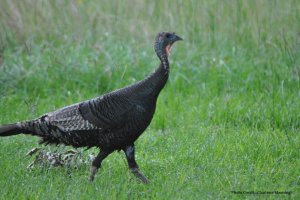
Eastern Wild Turkey Hen
The bodies of wild turkeys are covered with 5,000 to 6,000 feathers. These feathers provide insulation, lift during flight, and touch sensation and ornamentation. A wild turkey undergoes five molts (feather replacement) during its lifetime: natal, juvenile, first basic, alternate (first winter), and basic (adult plumage). The body feathers of toms are vibrantly colored: iridescent copper, bronze, red, green, and gold. While hens have these same colors, they are significantly dulled and muted which causes the female to appear brown. Gobblers have a beard, which is a cluster of long follicles in the center of their chest that can be an inch to 10 inches long. Unlike the rest of the body feathers which undergo 5 molts throughout an eastern’s lifetime, the beard does not molt. It becomes visible when the turkey is 6-7 months of age, and it continues to grow throughout their lifetime.

Turkey Beard
Hens may occasionally have beards, although this uncommon event produces much shorter beards than toms. Both toms and hens have sparsely feathered heads with bare legs and feet that are pink to red in color. Toms grow a spur on the lower third of their leg that starts off small and rounded, but which becomes pointed and about 2 inches long with time.
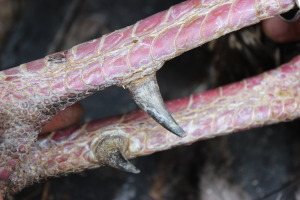
Tom spur
Hens also have a spur, although their spurs stay small and blunted. Gobblers weigh 17-21 pounds and attain a height of 40 inches. Hens weigh 8-11 pounds and are 30 inches tall. Poults are relatively small when hatched; they only weigh 2 ounces.
Eastern wild turkeys can be differentiated from Rio Grande wild turkeys by the coloration of the tips of the tail feathers and the upper tail coverts (feathers of the lower back, covering the base of the tail feathers). In Rio Grande wild turkeys, these feather tips are buff or tan, contrasting with the dark brown tips of the eastern wild turkey.
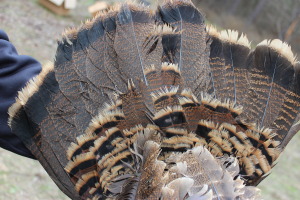
Turkey tail feathers
Mating and nesting
Gobblers attract a hen’s attention by gobbling and strutting. The hen will select a mate by lying close to the ground in front of him, which signals the male to begin copulation.
The breeding season is generally from March to June, with hens beginning to nest mid-April to mid-June. In open herbaceous habitats and thinned pine forests, females choose nesting sites in native bunchgrasses and forbs that afford adequate screening cover between 20 and 26 inches tall. In forested habitats, this screening cover is provided by dense shrubs and young trees. Nests are scratched out and form a shallow depression or bowl shape. Hens lay one egg per day, for an average total of 10 eggs.
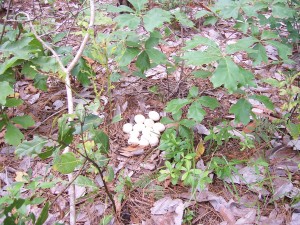
Turkey nest
The eggs are incubated for 28 days, after which the poults begin to hatch. The poults and the hatch then form a brood, and spend the majority of the poults’ first few weeks of life foraging for invertebrates.
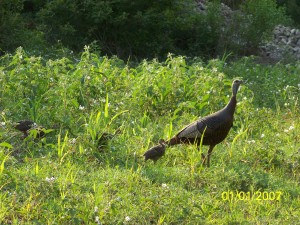
Hen with poults
Open herbaceous areas are important to broods because they supply a large source of invertebrates such as grasshoppers, beetles, and spiders. The poults continue to roost on the ground for the first two weeks of life until their natal plumage is replaced by flight feathers and they can fly up into roost trees.
Habitat and diet
Habitat diversity is important for eastern wild turkeys, which require an interspersion of forested areas and open grasslands to meet their needs. Open grasslands are necessary for turkey courtship in addition to providing the necessary seeds and insects for poults. Forested areas provide soft mast and cover for most of the year. 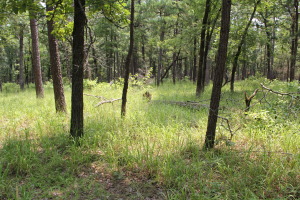
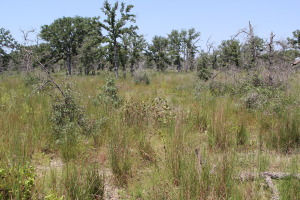 Forested areas must be well managed though for wild turkeys to utilize them. If the forest gets too dense, the wild turkeys main defense, sight, is compromised and they will no longer use it. Prescribed burning and forest thinning to maintain a forest landscape with reasonable visibility up to 60 yards and good understory growth is essential for wild turkeys.
Forested areas must be well managed though for wild turkeys to utilize them. If the forest gets too dense, the wild turkeys main defense, sight, is compromised and they will no longer use it. Prescribed burning and forest thinning to maintain a forest landscape with reasonable visibility up to 60 yards and good understory growth is essential for wild turkeys.
The eastern wild turkey is an opportunistic forager that feeds on green foliage, insects, seeds from grasses and forbs, and mast (acorns and nuts). Annually, their diet consists of about 36% grasses, 29% insects, 19% mast, and 16% forbs. The individual plant species that a turkey uses as food varies by region and by season. In east Texas, water is not a limiting factor. Eastern wild turkeys obtain water from standing sources such as creeks and ponds, as well as metabolic water obtained through their diets.
Predation and other mortality factors
Eastern wild turkeys are prone to predation from the nesting to adult stages of life. Half of all nests are lost to predation or abandonment. Poults are especially vulnerable to predation in the first few weeks of life when they still roost on the ground. In addition, they are also more likely to succumb to starvation, birth defects, and inclement weather. In fact, less than 50% of poults survive to be one month old in east Texas. The two most common nest predators are the American crow (Corvus brachyrhynchos) and the raccoon (Procyon lotor). Other common predators include snakes, feral pigs (Sus scrofa), opossums (Didelphis virginiana), great-horned owls (Bubo virginianus),
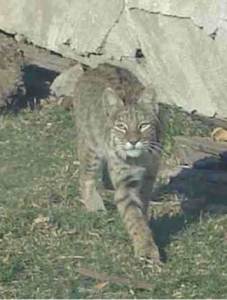
Bobcat
bobcats (Lynx rufus), and coyotes (Canis latrans).
In addition to predations, eastern wild turkeys are also susceptible to numerous diseases and parasites such as aspergillosis, mycoplasmosis, salmonellosis, and coligranuloma. Avian pox is another common infection that results in the growth of wart-like lesions on the infected turkey’s feet, legs, eyelids, and around the bill. These lesions prevent the turkey from foraging, resulting in a significant weight-loss that increases the turkey’s likelihood of being depredated.
Conservation and management
Up until 1881, eastern wild turkeys could be harvested year-round. In 1881, the Texas legislature passed the first turkey season, closing the season for three and a half months of the year. By 1907, a three-turkey bag limit was passed by the Texas Legislature. In 1941, the eastern wild turkey season was officially closed. Despite these and other preventative measures, by 1942 there were less than 100 eastern wild turkeys remaining in Texas. Although their population densities remain low, overhunting is no longer a limiting factor. In 1995, the eastern wild turkey season was reopened.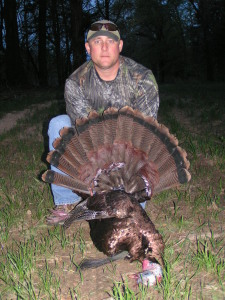
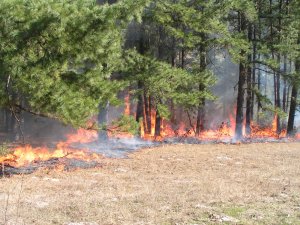
Prescribed burn
Landowners and land managers can improve the nesting and brood-rearing habitats of eastern wild turkey through practices such as prescribed burning, forest thinning, and grazing. This will contribute to habitat that is favorable for eastern wild turkeys and may result in more individuals being recruited into the population.
For more information on the biology and habitat requirements of the eastern wild turkey and general recommendations for landowners and land managers to implement, please see the resources below.
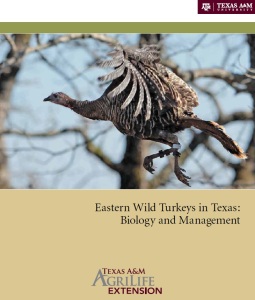
Eastern Wild Turkey Videos:
History of Eastern Wild Turkey
Eastern Wild Turkey Restoration: A Landowner’s Perspective
Nesting Requirements and Management for Eastern Wild Turkey
Managing Understory and Openings for Eastern Wild Turkey
Habitat Management for Eastern Wild Turkey
Managing Eastern Wild Turkey Nesting and Brooding Cover in Post Oak Woodlands